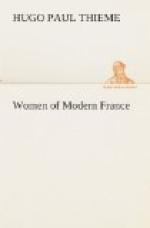Mme. de Sevigne never bored her readers with her own reflections. She differed from her contemporaries, who seemed to be dead to nature’s beauty, in her striking descriptions of nature. A close observer, she knew how to describe a landscape; animating and enlivening it, and making it talk, she inspired the reader with love of it.
“I am going to be alone and I am very glad. Provided they do not take away from me the charming country, the shore of the Allier, the woods, streams, and meadows, the sheep and goats, the peasant girls who dance the bourree in the fields, I consent to say adieu; the country alone will cure me.... I have come here to end the beautiful days and to say adieu to the foliage—it is still on the trees, it has only changed color; instead of being green, it is golden, and of so many golden tints that it makes a brocade of rich and magnificent gold, which we are likely to find more beautiful than the green, if only it were not for the changing part.”
If the style of her letters did not make her the greatest prose writer of her time, it certainly entitled her to rank as one of the most original. The prose of the seventeenth century lacked “easy suppleness in lively movement, and imagination in the expression”—two qualities which Mme. de Sevigne possessed in a high degree. The slow and grave development, the just and harmonious equilibrium, the amplitude, are in her supplanted by a quick, alert, and free saillie; the detail and marvellous exactness are enriched by color, abundance of imagery, and metaphors. M. Faguet says she is to prose what La Fontaine is to poetry.
The literary style of Mme. de Sevigne is not learned, studied, nor labored. In an epoch in which the language was already formed, she did what Montaigne did a century before, when, we may almost assert, he had to create the French language. Her most striking expressions are her own—newly coined, not taken from the vocabulary in usage. Her style cannot be duplicated, and for this reason she has few imitators. Her letters show that they were improvised—her pen doing, alone, the work over which she seemed to have no control when communicating with her daughter; to the latter she said: “I write prose with a facility that will kill you.”
Mme. de Sevigne was possibly not a beautiful woman, but she was a charming one; broad in the scope of her affections, she found the making of friends no difficult task. M. Vallery-Radot leaves the following picture of her: “A blonde, with exuberant health, a transparent complexion, blue eyes, so frank, so limpid, a nose somewhat square, a mouth ready to smile, shoulders that seem to lend splendor to her pearl necklace. Her gayety and goodness are so in evidence that there is about her a kind of atmosphere of good humor.”




